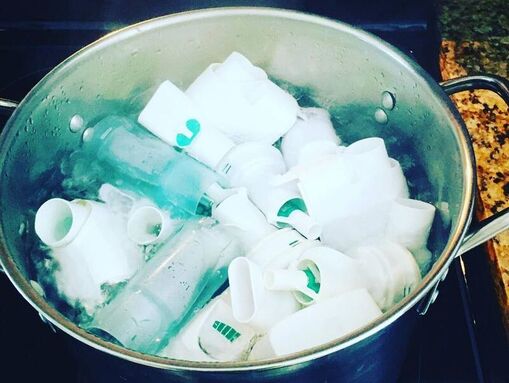|
Regardless of whether we have a mild or a more advanced case of bronchiectasis, whether we are currently taking antibiotics or not, whether we have lots of energy or very little, self-care is critical. Self-care is not necessarily the easiest way to manage a disease, but it can be the most individualized, rewarding and hopefully, successful way of living with a chronic condition.
The word “bronchiectasis” is a combination of the Greek words “bronckos” meaning airway and “ektasis” meaning widening or dilation. The last part, the “ektasis”, is what makes it an irreversible disease as the tissue has lost its elasticity from inflammation and infection. Think of the stretched-out waistband of an old pair of pajama bottoms. No amount of laundering is going to shrink that band. The same is true of our lungs. However, self-care will make it easier to keep our overstretched passages from clogging with sticky mucus and organisms−bacteria, viruses and fungi− that destroy tissue. Also crucial is adopting a healthy lifestyle to decrease overall inflammation. A commitment to healthy eating, exercise and rest will make a significant difference. You must take a committed approach because your body is smart. It knows the difference between a few toe-touches and a one hour stretch class at your gym. It knows the difference between shutting your eyes for five minutes and sitting down to your meditation practice fully present. It knows a quickie puff on the Aerobika versus a full-throttle attempt to get the mucus out. I want to be absolutely clear on a critical point: I am NOT advocating blowing off traditional medicine. I am a firm believer in a healthcare team with traditional as well as alternative care providers. I also believe in taking advantage of every service your multi-disciplinary team of providers has to offer. I now have a care team that supports my healing and is available to answer questions as they arise. It took me some time and effort to get to this point including traveling to another state for a second opinion and switching to a new pulmonologist. My new pulmonologist recommended that I see several other specialists who would look for possible causes of my disease. Over time, I added in some complementary medical practitioners to help me heal. In this way, I felt that we were working together and taking a holistic, individualized approach to my care. So, again, I urge those with BE to seek out the best medical care available in their community. If options are limited, and you have the resources, find a top national specialist to guide your local team. #bronchiectasis #pulmonology #airwayclearance #lunghealth
0 Comments
Michelle MacDonald, a clinical nutritionist at National Jewish Health, in an NTM Info & Research podcast series, presented on how food can impact bronchiectasis and NTM lung disease. Some suggestions are below (in a nutshell!). Recordings are available at NTMinfo.org.
• Eat with purpose and determination. Food is therapy to fight infection. You need the calories to strengthen the immune system and speed recovery. • Eat high-calorie, high protein, nutrient-dense foods. • Schedule your meals. Do not skip meals. Eat breakfast. Snack a couple of times a day. • If MAC is draining you, then eating well helps you fight your infection. It can help you restore yourself. • There is no single predictor of who will have disease progression, however, low body mass index (based on height and weight-BMI less than 18.5) is linked to a poorer outcome. We are not sure how sickness and being underweight are linked but, know that they are. Women like being on the thinner side. But MacDonald reminds women that they will be stronger if they are a normal weight or have a few extra pounds on them. Don’t diet if you are fighting infection and/or be sure your diet is carefully monitored. • Dairy does not necessarily increase mucus production based on the studies. However, you need to evaluate how dairy impacts your congestion on an individual basis. • Often loss of appetite is because of infection. Appetite loss might mean you need to eat more. Fever also increases metabolism and burns calories. • Vitamin D deficiency (a 30-50 level is considered good at NJH) means your body is fighting infection and using up micronutrients. This lowers your immunity. • Fat is more caloric and very healthy. Even if you have a history of heart disease. It can be a concentrated way to get the calories and nutrition you need. • Add and/or concentrate calories in each meal. Increase 250-500 calories per day. This way you will gain about a pound a week. You may need up to 2500 daily calories to reach this goal. • There is a higher need for protein with an active infection. MacDonald recommends a 4 ounce portion chicken, fish or meat. Size-wise it is bigger than a deck of cards. Some data shows that 30 grams of protein at each meal may increase muscle mass. • Sugar/desserts okay but should not be a substitute for more nutritious eating. • Take a multi-vitamin, iron-free. Some concern, that supplements with iron might promote growth of bugs. This is especially true if you are post-menopausal. Choose a 3rd party certified supplement (these companies audit supplements to see if they are high quality). Avoid megadoses of minerals and vitamins. Data shows that they could be more harmful than helpful. • Food supplements can be a good idea. Especially if you eat mainly vegan or vegetarian. • Reflux is correlated with NTM and bronchiectasis Reflux precautions: •Sleep on left side • Elevate head of bed 30-40 degrees • Do not eat within 3 hours of sleeping • Know what your triggers are and avoid or minimize • Eat small frequent meals You are in charge!!! #bronchiectasis #ntmlungdisease #maclunginfection #nutrition The bacteriophage, also known as phage, is a virus that kills bacteria. There are more phages than any other organism on earth and they are easily found and retrieved from ponds, lakes and the ocean. It is hard to believe but 40% of the bacteria in the ocean is killed by phages every day!
The phage looks like a microscopic land rover sent to explore another planet. Its twenty-sided head sits on a tail that has leg-like fibers attached to it. Each phage has the genetic makeup to destroy a specific bacteria. It uses its tail to puncture the host and inject its own genetic material into it, thereby turning the bacteria into a phage factory. When the bacteria is full, the phage manufactures a substance called endomycin to punch a hole in its host and release the newly made phages. Phages were identified by English bacteriologist Fredrick Twort in 1915 and French Canadian scientist Felix D’Herelle in 1917. D’Herelle realized that they could be used as antibacterial agents and over the years advanced his research by opening phage therapy centers throughout Eastern Europe. However, with the discovery of the miracle drug—penicillin-- by English scientist Alexander Fleming in 1928, interest in phage therapy decreased, especially in the West. Now, one hundred years later, the tide is turning and there is renewed interest in bacteriophage therapy. This interest is mainly due to the mutation of bacteria and fungi and the creation of Antibiotic Drug Resistant (ADR) superbugs caused by the overuse of antibiotics. According to the Center for Disease Control, close to three million people a year in the United States get ADR infections and 35,000 die from them. Unfortunately, the need for new antibiotics is not being met by the pharmaceutical industry. I first learned about phage research and therapy when I attended an NTM and bronchiectasis patient symposium a couple of years ago at Yale University in New Haven, Connecticut. Subsequently, I heard phage therapy brought up at a New York University Bronchiectasis and Non-Tuberculous Mycobacteria Symposium and more recently, last month at the 4th World Bronchiectasis Conference. More and more academic institutions and businesses are creating phage libraries and synthetic phages in the United States as well as around the world. Looking at phage therapy in contrast to antibiotics, we can more clearly see the pros and cons of this therapy that is now gaining attention: Advantages of Phage Therapy Over Antibiotics
Disadvantages of Phage Therapy Over Antibiotics
The good news is that finally there are several high-quality, controlled studies set to begin. They will test the efficacy of phage therapy, mainly addressing bacterial infections in the Cystic Fibrosis population. We are wading into a new era of quality data and I look forward to seeing the results and whether phage therapy is efficacious for the broader lung disease population. #bronchiectasis #phage #phagetherapy #pseudomonas What do I think is the best method of clearing airways? The simple answer is… whichever one you are willing and able to do on a regular basis. This activity is often prescribed to be done once or twice a day and even more frequently during respiratory infections and flare-ups. Hopefully, you will be able to meet with a therapist to review airway clearance practices. I say hopefully, because even in New York City, I had difficulty finding a therapist with this type of expertise. When I asked my first pulmonologist to refer me to a therapist specializing in airway clearance, he said that he did not know of anyone! So instead, I had a ten-minute airway clearance session with his nurse who asked me to choose between an Acapella® and an Aerobika®.
I knew nothing about the devices and blindly chose the Aerobika. Four months later when I attended a New York City support group, I found out that although most use the Aerobika some preferred the Acapella so I ordered one to test which one works the best for me. I experimented and, most times, I prefer the Aerobika but occasionally I do like to switch things up and use the Acapella. There are some contraindications for using these devices, so it is important that you get your health professional’s approval and not just order one online. I was not comfortable with the limited patient education I received in my doctor’s office, so I searched online for other resources. I found the Pulmonary Wellness & Rehabilitation Center in New York City, and met with a therapist there to review my airway clearance. The center was not on my health plan, but I felt it was important enough to pay for an experienced therapist to teach me the best ways to clear my airways, something I came to see as not only a science but also an art. A year later I switched to a new pulmonologist who referred me to an in-house hospital therapist to review my AC technique and make some minor recommendations. It was reassuring to know that, even with the therapist percussing me like a bongo drum, I did not expectorate more than my usual amount. My pulmonologist later said that, based on what she knew about me, I probably did not have a lot of mucus and that the techniques I was using were sufficient and effective. As you clock in airway clearance hours, try new approaches and get input from your therapist, you will learn what clearance tools in your bronchiectasis toolbox work best for you and when to use them. There is an expression, “A new broom sweeps the floor, but an old broom knows the corners.” It is my hope that once you get adequate professional input and try different practices, you will have the experience to know how to “sweep your corners” and have clearer lungs. #bronchiectasis #airwayclearance #nebulizing #Aerobika |
AuthorLinda Cooper Esposito, MPH is a health educator with bronchiectasis. She developed the BE CLEAR Method to Living with Bronchiectasis and writes with compassion and humor about this chronic lung disease. Archives
July 2024
Categories |





 RSS Feed
RSS Feed